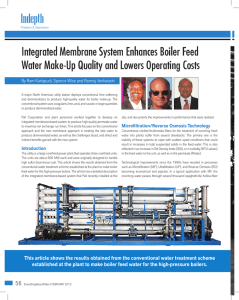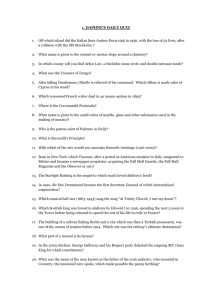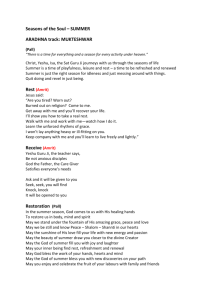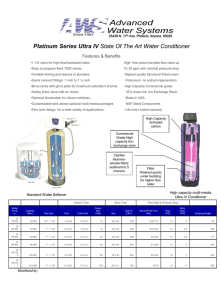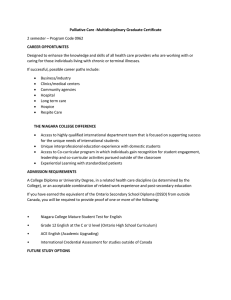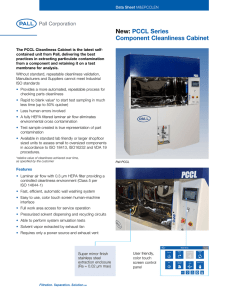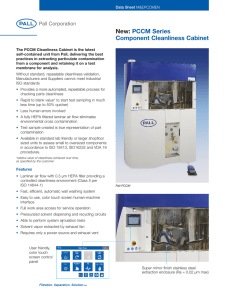Technical Paper Presented at Southwest Chemistry
advertisement
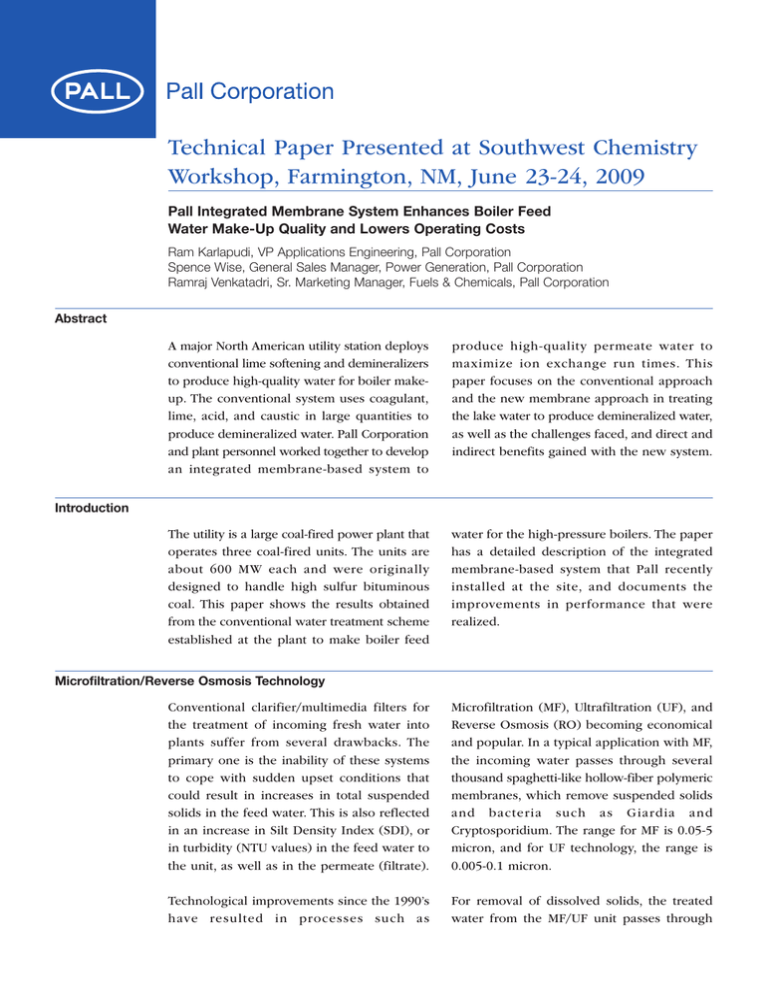
Technical Paper Presented at Southwest Chemistry Workshop, Farmington, NM, June 23-24, 2009 Pall Integrated Membrane System Enhances Boiler Feed Water Make-Up Quality and Lowers Operating Costs Ram Karlapudi, VP Applications Engineering, Pall Corporation Spence Wise, General Sales Manager, Power Generation, Pall Corporation Ramraj Venkatadri, Sr. Marketing Manager, Fuels & Chemicals, Pall Corporation Abstract A major North American utility station deploys conventional lime softening and demineralizers to produce high-quality water for boiler makeup. The conventional system uses coagulant, lime, acid, and caustic in large quantities to produce demineralized water. Pall Corporation and plant personnel worked together to develop an integrated membrane-based system to produce high-quality permeate water to maximize ion exchange run times. This paper focuses on the conventional approach and the new membrane approach in treating the lake water to produce demineralized water, as well as the challenges faced, and direct and indirect benefits gained with the new system. The utility is a large coal-fired power plant that operates three coal-fired units. The units are about 600 MW each and were originally designed to handle high sulfur bituminous coal. This paper shows the results obtained from the conventional water treatment scheme established at the plant to make boiler feed water for the high-pressure boilers. The paper has a detailed description of the integrated membrane-based system that Pall recently installed at the site, and documents the improvements in performance that were realized. Introduction Microfiltration/Reverse Osmosis Technology Conventional clarifier/multimedia filters for the treatment of incoming fresh water into plants suffer from several drawbacks. The primary one is the inability of these systems to cope with sudden upset conditions that could result in increases in total suspended solids in the feed water. This is also reflected in an increase in Silt Density Index (SDI), or in turbidity (NTU values) in the feed water to the unit, as well as in the permeate (filtrate). Microfiltration (MF), Ultrafiltration (UF), and Reverse Osmosis (RO) becoming economical and popular. In a typical application with MF, the incoming water passes through several thousand spaghetti-like hollow-fiber polymeric membranes, which remove suspended solids and bacteria such as Giardia and Cryptosporidium. The range for MF is 0.05-5 micron, and for UF technology, the range is 0.005-0.1 micron. Technological improvements since the 1990’s have resulted in processes such as For removal of dissolved solids, the treated water from the MF/UF unit passes through the RO membranes. This technology is employed before the demineralizers. The pores in the RO membrane are only a few angstroms in size and can remove a majority of the dissolved salts. The RO membranes (normally spiral-wound design) are easily susceptible to fouling and extra care is needed to limit the amount of suspended solids entering the RO. This means that the unit upstream of the RO membrane (MF, sand filters, etc.) must limit turbidity to less than 1 NTU and have an SDI less than 3. Modes of Operation The MF and UF filtration systems can be operated in the dead-end mode (outside-in flow) or in crossflow mode. The RO units operate in the crossflow mode. The MF unit described in this paper uses a hollow fiber PVDF membrane operated in the conventional dead-end filtration mode under pressure, where the feed water flows in from the outside to the inside of the hollow fiber and the suspended particles and bacteria are captured within the filter .The permeate is sent to the RO unit. The MF unit requires continuous air and chemical cleaning, which is described in a later section. The RO unit operates in the crossflow mode, in which the feed water flows parallel to the membrane surface. The water that is filtered through the fine pores (permeate) is mostly devoid of dissolved salts and is sent to the demineralizers for the polishing step before being used as boiler feed water. The portion known as the “retentate” or “reject” flows along the surface and is independently collected. Background Information Raw surface water from an adjoining lake is the fresh water source for the power plant. In the original treatment scheme, about 1500 gpm of this water was being treated with a conventional clarification and cold lime softening process followed by sand/gravel bed filtration. Demineralization units were subsequently used to produce the required water quality for the HP boilers. These units 2 consisted of a conventional cation bed using sulfuric acid for resin bed regeneration, and weak and strong base anion beds as well as a mixed-bed demineralizer using caustic soda for resin regeneration. Downstream of the demineralized units, the condensate water for the boilers was sent to storage tanks. A Graver Powdex® pre-coat filtration system was used for polishing condensate before the low-pressure heaters. The driving force to consider alternate treatment schemes in lieu of the conventional clarifier/sand bed was as follows: A. Chemical costs required to regenerate the demineralizer beds were extremely high since regeneration of the resin was carried out once a day or even more frequently. The ion exchange run time needed to be improved significantly. B. Operational simplicity: Frequent upset in the clarifiers would result in frequent regeneration. C. Although the plant was designed with a three-bed demineralizer followed by mixed-bed polishers to meet boiler feed water quality, silica breakthrough in the strong base bed was frequent and beds were regenerated more often. This is reflected in the chemical consumption shown in Table 1 (page 5). D. The condensate polishing system had to be precoated frequently due to the poor quality of the condensate water. An improvement in the frequency of precoating the resin would provide an indirect benefit to the plant. Quality of Incoming Water: According to information provided by the plant, the following was the quality of the incoming lake water for which the MF and RO units were designed. TDS 540 ppm Turbidity <10 NTU Iron 0.62 ppm RO Feed Water Quality Feed Stream Composition (mg/l) TDS <540 ppm Barium 0.01 Calcium 51.00 Potassium 3.18 Magnesium 20.90 Sodium 20.41 Chloride 22.35 Fluoride 1.30 Bicarbonate 238.00 Nitrate 0.50 Sulfate 29.00 Silica 16.00 Carbonate 0.67 Carbon Dioxide 7.59 Pall water treatment experts performed a detailed analysis of the plant conditions and decided to recommend an integrated membrane (MF/RO) system (IMS) to replace the cold lime softening clarifiers and sand/gravel filter beds. Since the power plant was online, an additional challenge was to install the systems without shutting down the demineralizer trains or negatively impacting the amount of treated water while the new IMS plant was brought on line. Pall recommended installing the IMS in parallel with the clarifiers and sand/gravel filters and reusing the existing filtered water tanks. One filtered water tank was used as an MF/RO break (filtrate tank), and the other as an RO permeate water storage tank (the new demineralizer train feed tank). After commissioning the IMS, the plant personnel bypassed the clarifier/sand bed system and fed the incoming water from the feed system directly into the MF system. The MF and RO product water quality that the units were designed for is shown below: MF Product Water Quality Feed Water Element Treated Water Quality Giardia and Cryptosporidium Undetectable Suspended Solids Undetectable Turbidity < 0.1 NTU RO Product Water Quality TDS: pH: < 25 ppm 5-7 Integrated System Details: Pall’s integrated system was commissioned in February 2008, which means there is more than one year of performance data to report. The installed MF system consisted of a Pall Aria™ Microfiltration system using Microza* microfiltration modules. The system consists of two independent treatment trains of 42 modules each. This system is 2 x 100% capacity (770 gpm maximum each) and allows for an average production of 1400 gpm (input of 1540 gpm with 95% recovery) with both trains in service. Since the IMS system was installed along with the existing system, the space available for the RO skid was limited. Therefore the RO skid had to be custom designed to fit in the available space. To accomplish this, the RO system consisted of three stages (single train), arranged in a 16:8:4 array with five membrane elements each. The inlet flow to the RO system was 625 gpm. The system was designed for a total permeate production of 500 gpm, the average capacity of the boiler. * Microza is a registered trademark of Asahi Kasei Corporation 3 Process scheme and sizing The RO system capacity was designed to meet an average demineralized water demand of 500 GPM. However, during boiler chemical cleans or tube leaks, the demineralized water demand could be as high as 900 GPM. During high demand conditions, the RO permeate will be blended with the MF filtrate. The demineralizer feed pump has the capability to draw from both MF filtrate and the RO permeate, thus blending the two streams before being fed to the demineralizer trains. The question that arises in the RO system design is “How frequent can the system start/stop?”, particularly when the demineralized water demand is below average capacity (500 GPM). Pall’s Water Team decided to tie the overflow line from the RO permeate water tank to filtrate water tank, thus achieving two goals: 1. Keeping the RO in service all the time and avoiding frequent starting and stopping 2. Improving the water quality to the demineralizer train. Since the RO permeate tank is full, the overflow would fill the filtrate tank. This will back off the MF filtrate, thus providing partial double RO product quality. With the above process improvement, the RO system had to self-regulate in terms of flow and pressure. Therefore the RO booster pump was equipped with a VFD and the reject valve is of the modulating type. The PLC would control the flow and pressure to maintain the constant product water flow and system recovery. The average MF filtrate required for the RO is 625 GPM and during the peak demand, the MF filtrate required would be 1,025 GPM to make the blended feed of 900 GPM to the demineralizer system. Flux Maintenance (FM) is being performed to lower Trans Membrane Pressure (TMP) across the MF membrane. There are three FM methods used in this system. 4 The first FM method is air scrub/reverse filtration (AS/RF), which involves injection of air at low pressure into the feed side of the module approximately every 20 minutes. Clean filtrate is also pumped in a reverse direction through the hollow fibers to dislodge foulants and deposits. After the AS/RF, the MF unit will ramp up to the instantaneous peak flow to compensate for the loss in filtered water, thus maintaining the constant average filtrate output. The second FM method is Enhanced Flux Maintenance (EFM), which is being performed based on an increase in the TMP. This fluctuates between once per day and once per week to remove microbial fouling, thus lowering TMP values. During EFM, a hot caustic chlorine solution or a hot chlorine solution is circulated through the feed side of the membrane. During the EFM the MF unit will be off line for 30 – 60 minutes. Normally, as TMP approaches 25-30 psig, a chemical clean-in-place (CIP) is performed -- the third FM method. This is a two-step protocol, first using hot caustic/chlorine, and then an acidic solution to return the modules to “nearly new” conditions. This is carried out hundreds of times over the lifetime of the modules. A CIP can also be performed at periodic intervals (once every 60 days, for example) as a precautionary step to protect the membrane even if TMP does not rise significantly during that interval. Considering the FM requirements for the MF system, two MF units were selected. Since the average demineralizer feed rate is 500 GPM (RO feed 625 GPM), each MF unit was sized for 700 GPM average filtrate production. See Figure 1 (page 5) for the overall mass balance for the project. Figure 1: Overall Water Mass Balance Diagram Flow: 1383 gpm TDS: < 540 ppm Turbidity: < 0.1NTU Flow: 1454 gpm TDS: 540 ppm Turbidity: 5-500 NTU MF Feed from River Micron Filter MF Train Three (3) 400 micron Two (2) Valve Rock Filtrate Break Tank RO Pre-Treatment Chemical Dosing System Hot Water System Flow: 500 gpm TDS: <25 ppm PH: 5-7 RO Train 220 M3 Flow: 625 gpm TDS: < 540 ppm PH: 6.5 Overflow from Demin Water Storage Tank TDS: <25 ppm Cartridge Filter Array: 16:8:4 (7 Element Each) # of Membranes: 126 Make: GE or Equivalent Recovery: 80% Operating Pr.: 120 pal Demin Water Storage Tank 220 M3 RO Product Water 5 micron Integrated CIP System for MF/RO Flow: 125 gpm TDS: 2800 ppm To effluent Collection Pond Legend: Raw Water MF Treated Water Chemical Conditioned Water RO Permeate Water RO Reject Water Result and Discussion Table 1 compares the existing costs for chemical addition and power requirements with the clarifier/sand-gravel bed operation prior to the plant switching over to the MF/RO system. Table 1: Chemical/Power Costs with Conventional Treatment Component Daily Consumption, lbs Unit Cost in USD Total Cost in USD Sulfuric Acid—93% (lb) 8054 0.05 402.70 Caustic Soda—50% (lb) 16000 0.18 2880,00 Sodium Aluminate—40% (lb) 1000 0.20 200.00 Lime—100% (lb) 750 0.06 45.00 Power –KWH 1630 0.05 81.50 Total Daily Cost $3609 Total Yearly Cost $1,317,358 The costs for caustic soda and sulfuric acid are extremely high, owing to the fact that the demineralizer train was regenerated at least once a day. Sodium aluminate/lime was used for the lime softening operation. Table 2. Chemical/Power Costs with Pall Integrated System The sludge treatment/disposal costs and some other costs have not been quantified. The chemical costs were considerable, exceeding $3500/day. Table 2 shown below lists the chemical addition and power costs in the plant after Pall’s integrated system was operational. There was a dramatic lowering of the chemical costs. Component Daily Consumption, lbs Unit Cost in USD Total Cost in USD Sod. Hypochlorite-12%(lb) 26 0.13 3.4 Citric Acid—50% (lb) 21.4 0.54 11.6 Caustic Soda—50% (lb) 181 0.18 32.6 Sod. Bisulfite—38% (gal) 58 0.43 24.9 Antiscalant—100% (gal) 2.2 35.00 77.0 Sulfuric Acid—93% (gal) 0 0.05 0 Power—KWH 2800 0.05 140.0 Total Daily Cost $289.5 Total Yearly Cost $105,650 5 The principal benefit of the Pall system is the significant improvement in the regeneration of the ion exchange units. The regeneration cycle in the demineralizers improved from daily to once every 5-6 days. This led to a steep decrease in the use of caustic soda and sulfuric acid used in the resin bed regeneration. The use of sodium aluminate and lime was eliminated by bypassing the clarifier operation. The chemicals used to clean the MF/RO system during EFM and CIP (sodium hypochlorite, caustic soda and citric acid) are commodity chemicals and usage quantities are negligible compared to the conventional system. Antiscalant was used to prevent LSI scaling in the RO unit, while sodium bisulfite was used for dechlorination (described later). All of Figure 2: Turbidity of incoming water and permeate from the MF Unit these chemicals resulted in a daily cost of approximately $150. As indicated in Tables 1 and 2, the resulting daily savings in chemical/power costs is $3310 per day ($3600 - $290), or about $1.2 million per year. Figure 2 shows the variation of the turbidity of the incoming surface water and the turbidity of the filtered water from the MF unit with time over a period of several months. The incoming water varies in the range of 1.5 - 4 NTU, with occasional higher values. MF filtrate always exhibited turbidities below 0.05 NTU, with a majority of the readings less than 0.02 NTU. Variation of Turbidity versus Time 6 5 Turbidity (NTU) 4 3 2 Inlet Water Quality 1 Filtrate Quality from Microfiltration-1 Unit 0 0 10 20 30 50 40 Days of Operation The classic Silt Density Index (SDI) method was used to determine the fouling potential of the RO membrane. SDI is measured manually before the RO “guard” filter. Figure 3 demonstrates the variation of SDI. All the 6 60 70 80 readings were in the range of 1-3, with a majority of the SDI values being below 2.0. This again demonstrates consistent MF performance and fouling protection for the RO. Figure 3: Variation of Silt Density Index after Microfiltration Variation of Silt Density Index Versus Time after Microfiltration 5 4.5 4 SDI Value 3.5 3 2.5 2 1.5 1 0.5 0 0 10 30 20 50 40 60 70 80 Days of Operation The flow rates to both the MF Units vary in a wide range, depending on the demand. Trans Membrane Pressure (TMP) readings across MF Unit 1 have been plotted in Figure 4 below. Since the variation in flow rates is wide, the normalized TMP values are shown. It is important to note that the normalized TMP values appear to increase marginally with time but do not show a steep increase, which normally indicates that a chemical CIP is required. We commented earlier that Enhanced Flux Maintenance (EFM) is being carried out once a day to control the rise in TMP values. Nevertheless, a CIP procedure is carried out every 60 days on both MF units as a precautionary step to optimize MF performance. Variation of Normalized TMP versus Time for Rack-1 MF Figure 4: Trans Membrane Pressure Normalized for Flow Rate variation versus time 5 4.5 (TMP/Flow Rate) *100 4 3.5 3 2.5 2 1.5 1 0.5 0 0 10 20 30 40 50 60 70 80 90 Days of Operation 7 Figure 5 shows the operation of Stage 1 of the RO unit. The outlet pressure over several months is steady and actually declines slightly. The figure also demonstrates the pressure drop across the elements in Stage 1 and it Figure 5: Variation of outlet pressure and differential pressure across RO Stage 1 shows no increase. This demonstrates the excellent RO performance of Stage 1, and is characteristic of a very low fouling tendency. Although not shown here, similar results were obtained for Stages 2 and 3 of the RO unit. Variation of Delta P and Outlet Pressure for RO Stage 1 160 140 Outlet Pressure or Delta P 120 100 Outlet Pressure 80 60 40 Delta P 20 0 30 40 60 50 70 80 90 Days of Operation Operational Challenges Although the utility has achieved satisfactory performance in more than 15 months of continuous operation with the MF/RO unit, some technical challenges had to be met: 1. Filtered water tanks were old and unpainted. Therefore, even though the MF filtrate was of very high quality, the SDI at the RO inlet was consistently high (> 5). Due to these high suspended solids, the RO “guard” (cartridge) filter would not last more than a week. Upon investigation, we found that the filtered water tank had all the lime sludge and the iron crud as the tank was never painted. A high-density polyethylene (HDPE) tank was brought on site to replace the existing filtered water tank, which was then cleaned. With the HDPE tank online, the SDI at the RO inlet was consistently below 3.0. 2. During the early summer, the “guard” (cartridge) 8 to the RO unit, a two-micron Ultipleat® High Flow cartridge filter needed replacement every two or three days. This time it was not the SDI that was fouling the cartridge filter as the SDI was below 3. However, the fouling was from the microbial growth due to algae blooms in the lake. The microbial growth had to be stopped in order to increase the life of the cartridge filters. It was recommended that sodium hyprochlorite be added in front of the MF units to maintain free chlorine residue in the filtrate tank. Further, we wanted to utilize the residual chlorine in the cartridge filter to prevent the microbial growth. Therefore it was decided to move the sodium bisulfite dosing downstream of the cartridge filter. In other words, the system-engineered design was changed. These changes resulted in the run length of the cartridge filter increasing from one week to five months. These steps helped to mitigate the problems associated with algae formation on the cartridge filter. Indirect Savings system was effective in reducing total organic carbon content to very low levels in the condensate, and this had an immediate positive impact on the performance of the condensate polishing system. The total precoat cost decreased, contributing to substantial savings of approximately $250,000/yr. These savings were in addition to the $1.2 million/yr saved in chemical costs, as described earlier. The utility power plant deploys a Powdex condensate polishing system (three vessels per unit) for handling the condensate. These systems are installed to meet stringent boiler feed water requirements, to improve the reliability of production, and to increase the efficiency of the power plant. Prior to installation of Pall’s integrated system, the conductivity from the condensate system to the boilers was elevated, possibly due to high total organic carbon content. These precoatable filters were precoated at a very high frequency – once a day. Since it costs approximately $850/pre-coat, the plant was spending $1100/day for pre-coating work for the two polishing units during operating times and start-ups. Return on Investment The cost of the Pall Integrated System was approximately $1.2 million. Savings from chemical costs from installation of system: $1.2 million/yr. Savings from improved performance of polishing system: $250,000/yr. Hence, total savings to the plant: $1.2 +$0.25 = $1.45 million/yr. The return on investment was achieved in less than 10 months of operation. Since the operation of the integrated system commenced, the frequency of the pre-coating has decreased from once a day to once a week. The double-membrane (MF/RO) IMS Conclusions 1. Pall’s integrated system resulted in considerable direct savings on chemical costs and improved ion exchange unit run times. lifespan of the precoatable elements. Changing elements every two years may extend to five years. 2. Considerable indirect savings were achieved by reducing the frequency of pre-coat operation in the condensate polishing system. Also included in these costs was the average 3. Challenges associated with the plugging of the RO pre-filters in summer were overcome with an innovative technical solution. 25 Harbor Park Drive Port Washington, NY 11050 Phone: 516.484.3600 Fax: 516.484.6247 To find a Pall representative in your area, please go to www.pall.com/contact Visit us on the Web at www.pall.com Pall Corporation has offices and plants throughout the world. © Copyright 2009, Pall Corporation. Pall, trademarks of Pall Corporation. Pall Corporation. PGMFROSTR , Pall Aria, and Ultipleat are is a service mark of June 2009
